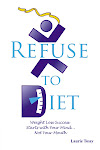Stuffing our feelings down with a side of our favorite food is a habit that we have to break in order to have permanent weight loss success. Not an easy thing to do.
We may backslide from time to time...even after a long period of success. This does not mean that we as human beings are failures, just that we are human!
Weight Loss Tip: write down several options that you have for dealing with emotions and keep that list handy--we must learn to express our emotions, to get them out...and to learn that it is safe to do so!
What should be on the list?
The specifics of your list must be up to you. No one else can tell you what to write on your list, because no one else knows how you feel and what will help you. There are no "shoulds," as in specific things that belong on the list or do not belong on the list.
That being said I have a couple general rules or guidelines that I suggest you follow for the permanent mindset shift that you need for weight loss:
- Avoid having food items on the list--not even healthy substitutions. This doesn't do anything to break the habit of eating to deal with emotions. It doesn't retrain our brain or our bodies if we grab a low-calorie something (including carrot sticks!) instead of a pint of ice cream.
- Vary the time required: sometimes you might only have (and need) a 10 second diversion. Other times you might need a minute, or 5, or 10 or 30...sometimes a quick attention snap is all we need (and all the time we have!) to make a conscious choice rather than grabbing something to eat without thinking. At other times we can, need to and deserve to take a longer, slower approach to the emotional issue at hand.
- Give yourself options. Even when coming up with things to do in different time frames, try to come up with at least 2 different things. Not all activities are suitable for the office, for example, and not all activities will feel right at the given time.
- Mix up the solution type. Don't have everything on your list be physical--there will be times where you are not up for a physical solution. On the other hand, don't merely list things that involve talking or are only solitary. By increasing the variety of solutions you increase your chances for success!
- Gather your tools. This is basically the Boy Scout motto of Be Prepared. If your list includes going for a walk then you need to have walking shoes available otherwise you will be creating an excuse why you can't do the substitute activity and be more apt to just eat...even if you don't consciously go through the thought process. If you need a timer, a picture that helps calm you, music, whatever it is you need...have various tools with you at work and at home and in your car so you can tap into the strength of your list!
10 second solutions: count to 10; primal scream (either silent or vocalized); squeeze a stress ball; scrunch up your face & stick out your tongue
One minute wonders: close your eyes & take 5 or 6 deep belly breaths; shadow boxing; dance; get up & slam a door or throw a pillow; laugh; pet the dog/cat; think about someone you love; visualize the person who is stressing you as a little child; throw a tantrum (not a real one--but get your body involved in expressing your anger/fear/hurt)
Longer remedies: go outdoors & throw rocks as hard/far as you can; go for a walk around the block/building; meditate (5 min/15 min or longer); listen to your favorite album; engage in a hobby; work on a puzzle; lift weights; dance; laugh; sing; get out in nature; play with your kids/pet
Keep it Handy
Now that you have your list of things you can do instead of eating when your emotions are hitting hard post it on your refrigerator and/or pantry...wherever your comfort food resides.
Keep a copy in your wallet or purse.
Have a copy at your desk at work so if you are tempted to hit the snack machine you see it first.
Make a copy for your car so you see it whenever you are tempted by the drive through or you are going grocery shopping.
Sometimes you don't even need to review the list--especially after you have been at this for a while--just seeing the piece of paper and knowing what is on it may be enough to help you make the shift you need to avoid emotional eating.
Last, but not Least: REFER TO THE LIST
Just writing it down may feel good at the time, but it won't have a lasting effect. To have permanent weight loss success we have to make changes in our behavior...and this is a way to make some small yet very powerful changes that WILL result in a healthier you--if you use it.
This is just a tool...and tools don't do the job by themselves, they rely on the user to pick them up and put them to work!



